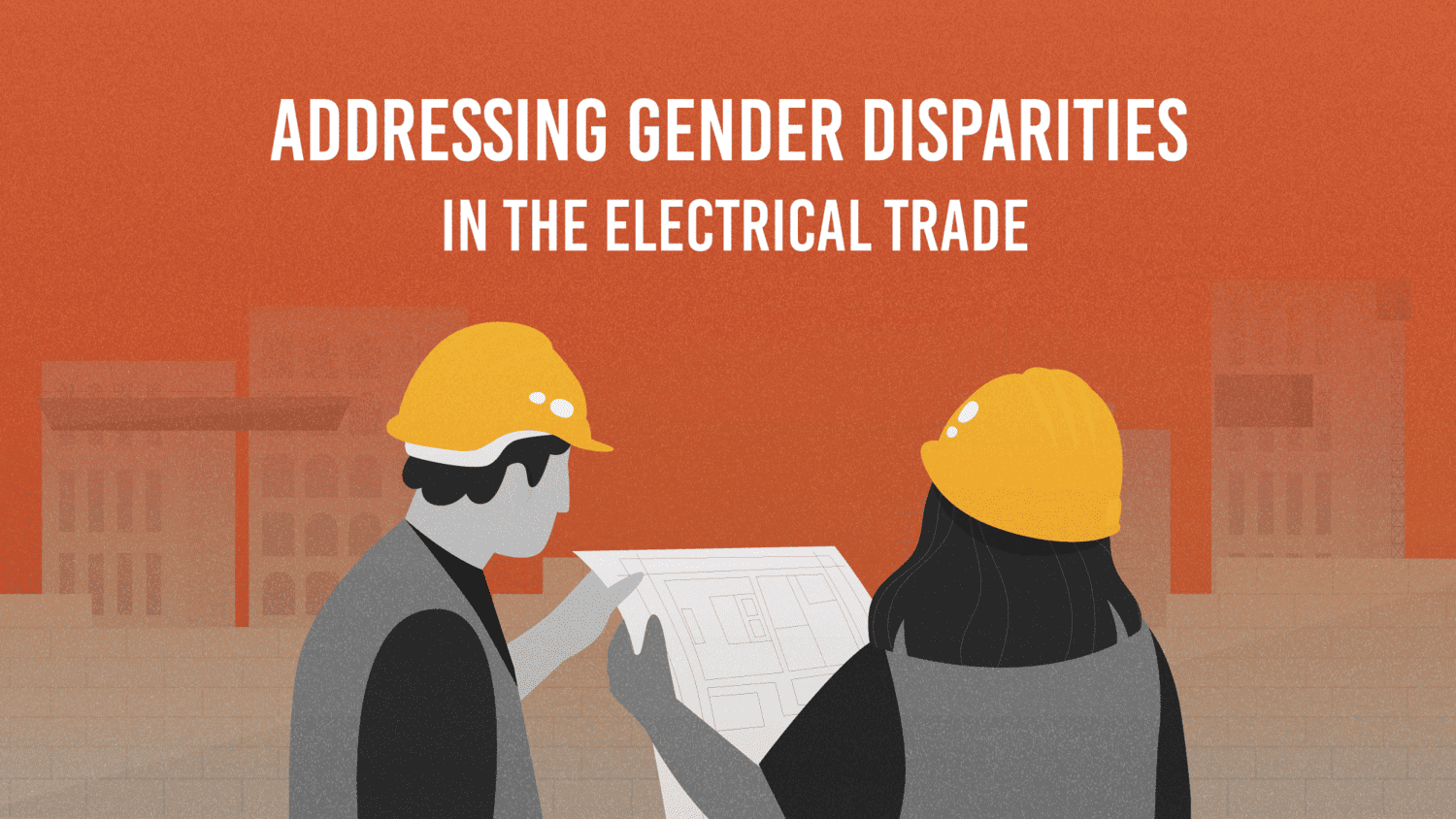The electrical trades present an interesting case regarding gender disparity in the workforce. While traditionally male-dominated, the field is slowly experiencing a shift towards greater inclusion and diversity. The positive developments offer hope for a more inclusive future to address gender disparities in the electrical trade. About 9 in 10 tradespeople believe that making the trades more welcoming to women helps get more people involved in the industry, aside from addressing job shortages.
Diversity in an otherwise monolithic trade sector can bring more innovative ideas and help deal with the issue of shortage of skilled workers. There is still work that needs to be done to address the gender disparity in the trades. From changing the stereotype to providing job opportunities, making the trades less gender-restrictive can be achieved through positive actions. Here, we’re going to explore the challenges and possible initiatives that will make trades more welcoming to all genders interested in pursuing a thriving career in the trade sector.
Challenges When It Comes to Gender Disparities
Underrepresentation of women in the electrical trade
Women constitute a minority in the electrical trades, including occupations such as electricians, electrical engineers, and technicians. It’s one of the most visible gender disparities in the electrical trade, where the representation of women in these roles remains considerably lower compared to their male counterparts. Women electricians comprise only 4.4% of the total workforce. In the construction industry, only about 10% of the workers are women.
The existing male-dominated culture within the electrical trade can create unwelcoming and hostile work environments for women. This can lead to feelings of isolation, making it difficult for women to establish themselves and progress in their careers. They may feel that they don’t belong and find it difficult to work comfortably seeing fewer workers of the same gender in the workplace.
Workplace discrimination and stereotypes
Gender stereotypes and societal perceptions often influence career choices. The electrical trades have historically been perceived as male-dominated, and these stereotypes may dissuade women from pursuing careers in this field. Prejudices and biases in the hiring and promotion processes can disadvantage women. Employers may hold unconscious biases, leading them to overlook qualified women or promote less-qualified male counterparts.
As a traditionally rugged job that requires physically demanding job activities, women are typically overlooked in the hiring process. This is despite advancements in technologies where manual labor is diminished in their job duties. Also, technical skills go beyond gender – this is another factor that contributes to the stereotypical hiring of men rather than women for job positions in the trades.
Lack of mentorship and support networks
Women in the electrical trades often face a lack of mentorship and role models. The absence of female leaders and mentors can make it difficult for aspiring female electricians to visualize their own career success in the trades. Women may feel isolated in male-dominated workplaces, limiting their networking opportunities. A lack of professional connections can hinder career advancement, as networking is crucial for learning about job opportunities, gaining industry insights, and accessing support.
When they see no workers of the same gender pursuing success in the trades, it translates to the idea that they may also not be able to carve a successful career path in the sector. They may not have heard of or met women who took on important job positions or ran contracting businesses, making it difficult for them to see themselves as suitable to join the trades.
Initiatives and Strategies for Change
Promoting education and awareness
Encouraging girls to pursue education in science, technology, engineering, and mathematics (STEM) from an early age can help break down gender stereotypes. Collaborate with educational institutions to develop and promote STEM courses and apprenticeship programs that actively encourage the inclusion of women. Offering scholarships or financial incentives for women pursuing electrical trade education can also be effective. Educational programs and outreach initiatives can highlight the diverse career opportunities available in the electrical trades. The Power Girls Electrical Day is an excellent example of such an initiative to expose the trades early on to young girls.
Public awareness campaigns are also effective in highlighting the achievements of women in the electrical trade. These campaigns can challenge stereotypes, showcase success stories, and emphasize the importance of diversity in the workforce. Through various media channels, interested individuals of all genders will have the chance to learn about the various opportunities open to them.
Creating a supportive and inclusive workplace culture
Companies should prioritize creating inclusive and supportive work environments. This involves implementing diversity and inclusion policies, conducting sensitivity training, and actively addressing instances of discrimination or bias. Provide training for all employees, including leadership, on diversity and inclusion. This training should address unconscious biases and stereotypes, promoting a culture of respect and equality.
Establish and enforce zero-tolerance policies against discrimination, harassment, and gender-based bias. If possible, establish ERGs focused on gender diversity. These groups provide a platform for employees to share experiences, offer support, and collaborate on initiatives that foster a more inclusive workplace.
Establishing mentorship and networking programs
Mentorship plays a crucial role in supporting career development. Establishing mentorship programs where experienced professionals guide and support women entering the electrical trades can provide valuable insights, networking opportunities, and emotional support. Facilitate networking events and online platforms where women can connect with mentors, peers, and industry professionals. These opportunities enable the exchange of ideas, experiences, and career advice, fostering a sense of community and collaboration.
Leadership development initiatives are also crucial to addressing gender disparity in the electrical trade. Offer leadership development programs specifically tailored for women in the electrical trade. These programs can provide skills training, career planning, and exposure to leadership roles, ultimately preparing women for advancement within the industry.
Success Stories in the Electrical Trade
The National Electrical Contractors Association (NECA) has a Women in NECA (WIN) initiative that aims to advance women in the electrical contracting industry. It is a program within the National Electrical Contractors Association (NECA) designed to support and promote the inclusion and advancement of women in the electrical construction industry. WIN provides resources, networking opportunities, and mentorship to women pursuing careers in the electrical trades. The success stories within this initiative demonstrate how mentorship and support can contribute to women’s success in the field.
Best Practices for Inclusive Work Environments
Implementing gender-inclusive recruitment practices
Companies can actively work towards eliminating biases in recruitment processes. This includes crafting gender-neutral job descriptions, ensuring diverse interview panels, and implementing blind recruitment techniques to focus on skills and qualifications rather than gender. Ensure that hiring panels include a diverse range of individuals. Having a mix of genders, backgrounds, and experiences can help mitigate unconscious biases and ensure a fair assessment of candidates.
Craft job descriptions that use inclusive language and focus on the essential skills and qualifications needed for the position. Avoid gender-specific terms and requirements that may inadvertently discourage qualified candidates from underrepresented genders.
Focus on Skills, not Gender
The emphasis on technical skills and qualifications over gender is crucial in creating a more inclusive environment. Apprenticeship programs and training initiatives prioritize meritocracy, opening doors for qualified individuals regardless of their gender. Shift the focus of hiring decisions towards a competency-based approach. Emphasize the skills, qualifications, and experience necessary for the role rather than relying on traditional gender-based assumptions. This ensures that candidates are evaluated on their ability to perform the job effectively.
Establish transparent career pathways that outline the skills and experiences needed for advancement. This clarity enables employees to set realistic career goals and understand the steps required to progress within the organization, irrespective of gender.
Future Outlook
Gender diversity has the potential to bring about transformative changes in the electrical trades, creating a more innovative, inclusive, and dynamic industry. By actively promoting diversity and fostering an environment where individuals of all genders can thrive, professionals in the electrical trades can position themselves for sustained success.
While positive changes are occurring, addressing gender disparity in the electrical trades remains an ongoing process. Continued commitment from stakeholders, including businesses, educational institutions, and policymakers, is essential for sustained progress. As these efforts continue, the trades industry can look forward to a future characterized by greater diversity, equal opportunities, and a more inclusive and supportive work environment for everyone.





